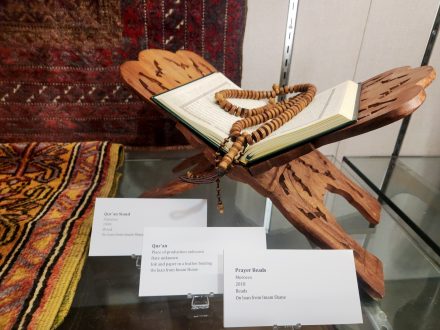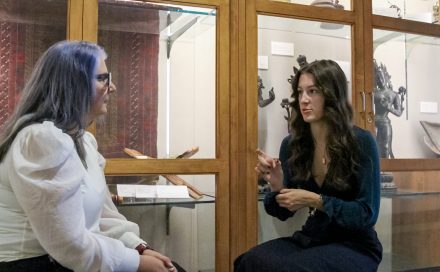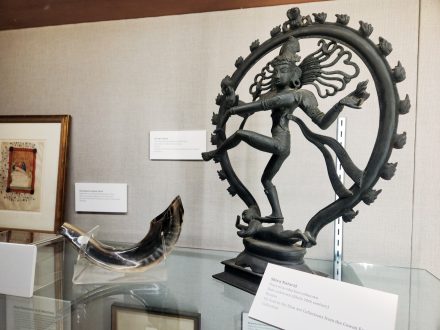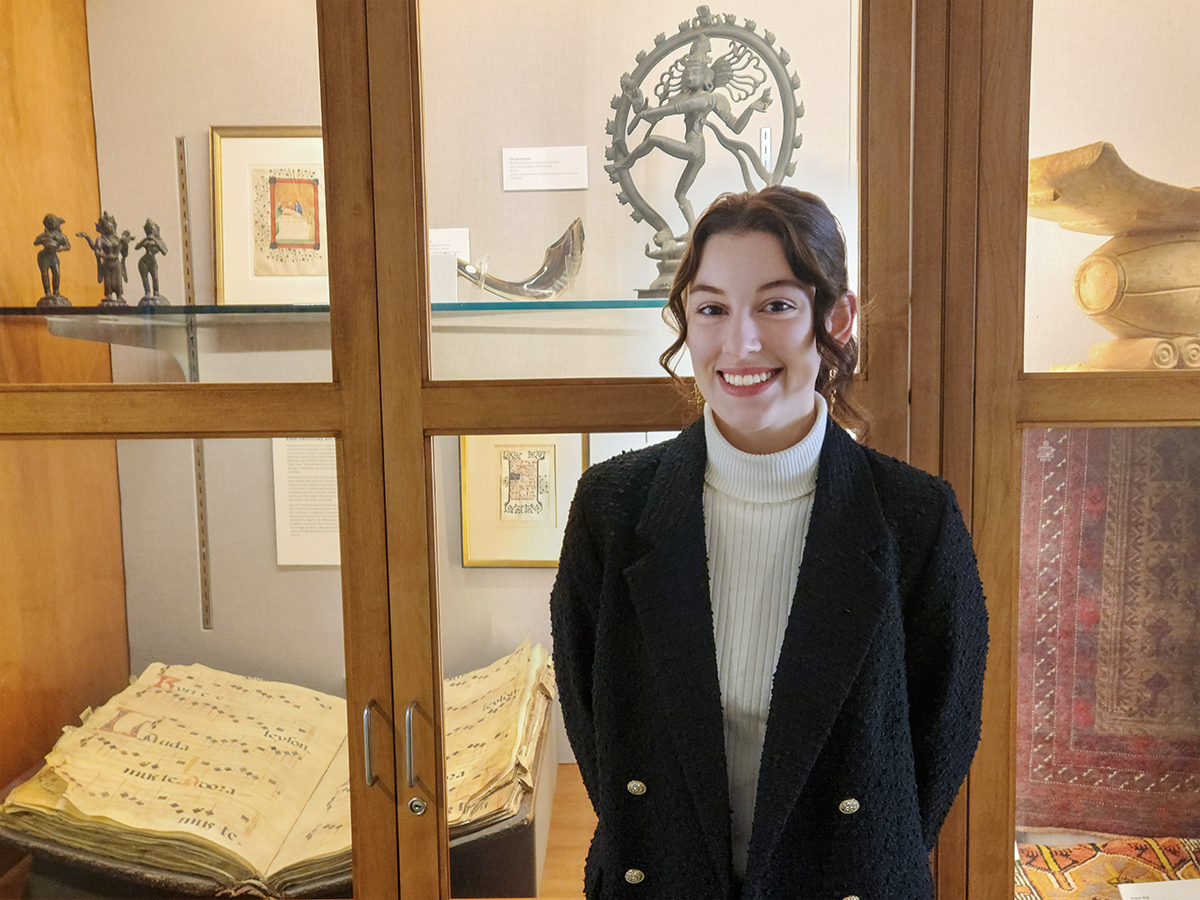Curator and Elon College Fellow Madeleine Hollenbeck invites feedback on Numen Lumen Pavilion exhibition featuring ritual art.
An evolving exhibition of multifaith religious art and artifacts in Numen Lumen Pavilion aims to provoke conversation and reflection — and the campus community is invited to weigh in as it’s completed.
Madeleine Hollenbeck ’24 spent the fall semester curating the pieces on display in the pavilion’s first floor hallway to represent Christian, Jewish, Muslim, West African and Buddhist traditions. Pages from medieval missals, a shofar and menorah, a Qur’an, prayer beads and figures of deities from Hindu and African religions: What meanings do they confer on their own, and what messages do they transmit when juxtaposed with each other?

Hollenbeck asked students, faculty and staff to weigh in on those ideas and to share personal experiences with objects in the cases. A QR code included in the exhibit takes users to an online survey asking about their religious background and experience with ritual art as well as suggestions, questions or observations. That feedback — including comments received over J-term — will guide the exhibit’s final curation before a spring opening event.
“This exhibit is a continuous process, so while I will officially open it in the spring as a culmination of my project, I will still be accepting feedback and adjusting things in the exhibit as I learn more,” she said.
Hollenbeck is curating the exhibit as her two-year research project in the Elon College Fellows program. With her mentor, Professor of Art History Evan Gatti, she’s spent hours considering what each piece represents, digging into the history of their origins and understanding their context within faith traditions.
The project began when Hillary Zaken, interim assistant dean for multifaith engagement, saw an opportunity around the Truitt Center’s 10th anniversary to use the art cases in Numen Lumen Pavilion to create multifaith dialogue. Zaken wanted to employ artworks from the Elon University Collection — and others available through faculty, staff and private sources — “to inform the community about religious and spiritual identities and traditions, challenge them to think critically, and provide creative ways to engage with the work the Truitt Center does.”

Zaken contacted Gatti and Coordinator of the University Art Collection Ethan Moore. Gatti was already working with Hollenbeck — an art history and arts administration double major from Romansville, Pennsylvania — to identify a space to curate and exhibit historical and significant artworks.
Hollenbeck leapt at the opportunity, expanding her initial focus on Italian Judeo-Christian artwork to incorporate artifacts from other faith traditions loaned by chaplains in Religious and Spiritual Life, Elon’s Hillel, Gatti, the Cowan Family and the university’s collections.
It’s already having the intended effect, Zaken said. Students and faculty visiting the sacred space or with Truitt Center staff frequently stop to explore pieces in the case and strike up conversation.
Hollenbeck recently added QR codes linking to videos of the items in use and to more information about their context within religious rites and rituals to drive engagement. She was inspired by her research in New York City and Florence, Italy — particularly at the Museo dell’Opera del Duomo, which houses many of the original works of Florence Cathedral. The museum uses links, videos and interactive features to engage patrons with artworks and themes.

“I was paying attention to how museums displayed religious art and was interested in ways of reanimating that art and bringing it back to its original context using multi-sensory aesthetics,” Hollenbeck said. “I want to provoke the conscious and unconscious experience of viewing art in a museum by incorporating light and sound instead of just static pieces.”
These are aspects she and Gatti have spent long hours contemplating and discussing, along with the significance of displaying the items together while remaining sensitive to each tradition represented.
Hollenbeck will continue to tweak the display into the spring based on campus feedback. She is also working on a paper about the project which she plans to present at conferences this spring.
“I was nervous to undergo such a long research project at first, but it has been such a wonderful process,” Hollenbeck said. “I realized through this that I want to continue conducting research, which is why I’ve been applying to art history graduate programs.”
Working closely with Gatti in this and other projects has broadened her horizons. She appreciates Gatti’s curiosity and attention, noting that her mentor often connects her with students and faculty whose perspectives are valuable to her research. Gatti also supported her study abroad experience in Florence, an internship in Sorrento, Italy, and her ongoing graduate school application process.
“Dr. Gatti has helped me explore the discipline of art history far beyond my comfort zone, and I can confidently say that some of my formative Elon experiences were largely influenced by her,” Hollenbeck said.
The Elon College Fellows is a four-year academic and professional program that explores the breadth, depth and connections within the arts and sciences. The program includes seminar courses and activities that form a community of learners and culminates in a two-year research project closely mentored by a faculty member in Elon College, the College of Arts and Sciences. College Fellows receive annual scholarships, a one-time travel grant to support study abroad, and research funding as part of the experience.



